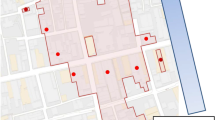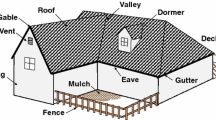Abstract
This study examines the size distribution and other characteristics of firebrand exposure during the 2007 Angora fire, a severe wildland–urban interface fire in California. Of the 401 houses that received direct interface fire exposure 61% were destroyed and 30% did not burn at all. The ignition of buildings by wind-driven firebrand showers and the starting of “spot fires” in unburned vegetation ahead of wildfires have been observed for some time. Empirically quantifying the exposure severity or describing how many firebrands of what size and over what duration and distance cause ignition problems of concern has not yet been possible. However, a unique opportunity to gather empirical firebrand data from an actual interface fire evolved in the days immediately following the Angora fire. Digital analyses of burn patterns from materials exposed to the Angora fire were conducted to determine firebrand size distributions. It is probable that some burn patterns were larger in area than the firebrands due to progressive combustion or melting, but it was assumed that the overall size distributions of burn pattern areas were representative of actual firebrand sizes. This assumption was investigated by exposing sections of materials collected in the Angora fire to wind driven firebrands generated in the laboratory using the unique NIST Dragon’s lofting and ignition research facility (NIST Dragon’s LAIR facility). The firebrand size distributions reported were compared to firebrand size distributions from experimental firebrand generation in both recent laboratory building ignition studies conducted by NIST and from historical firebrand field studies. Such data is needed to form the basis of effective and appropriate interface fire hazard mitigation measures as well as modeling fire spread. Comparisons are made to current wildfire protection building construction regulations and test standards. The most salient result of this study is documentation of the consistently small size of firebrands and the close correlation of these results with the sizes of experimentally generated firebrands.









Similar content being viewed by others
References
Koo E, Pagni PJ, Weise DR, Woycheese JP (2010) Firebrands and spotting ignition in large-scale fires. Int J Wildland Fire 19:818–843.
Pagni, PJ, Woycheese, JP (2000) Fire spread by brand spotting. In: Fifteenth meeting of the UJNR panel on fire research and safety, National Institute of Standards and Technology, Building and Fire Research Laboratory, Report # NISTR 6588, Gaithersburg, MD, pp 373–380
Fradkin PL (2006) Great earthquake and firestorms of 1906—how San Francisco nearly destroyed itself. The University of California Press, London
Foote EID, Cole D (1993) Making a case for “The Interface”. Fire Chief Mag. 37:59
Stewart SI et al. (2007) Defining the wildland–urban interface. J For. 105:201–207
Butler CP (1974) The urban/wildland fire interface. In: Proceedings of western states section combustion institute papers, vol 74, no 15. Washington State University, Washington
Mell WE, Manzello SL, Maranghides A, Butry D, Rehm R et al. (2010) The wildland–urban interface fire problem—current approaches and research needs. IJWF 19:238–251
Maranghides A, Mell WE (2011) A case study of a community affected by the witch and guejito fires. Fire Technol 47:379–420
Wilson AAG, Ferguson IS (1986) Predicting the probability of house survival during bushfires. J Environ Manag 23:259–270
Ramsay GC, McArthur NA, Dowling VP (1986) Building survival in bushfires. In: Fire science 186: The 4th Australian national biennial conference, Adelaide 17 p
Abt R, Kelly D, Kuypers M (1987) The Florida palm coast fire: an analysis of fire incidence and residence characteristics. Fire Technol 23(3):186–197
Gordon DA (2000) Structure survival in the urban/wildland interface: a logistic regression analysis of the Oakland/Berkeley tunnel fire. MS thesis, University of California at Berkeley, 447 pp
Foote EID (1994) Structure survival on the 1990 Santa Barbara “Paint” fire: a retrospective study of urban–wildland interface fire hazard mitigation factors. MS thesis, University of California at Berkeley, p 129
McArthur NA, Lutton P (1991) Ignition of exterior building details in bushfires: an experimental study. Fire Mater 15:59–64
Foote, EID, Martin R, Gilless JK (1991) The defensible space factor study: a survey instrument for post-fire structure loss. In: Proceedings of 11th conference on fire and forest meteorology. Society of American Foresters, Missoula, 8 p
Mitchell JW, Patashnik O (2007) Firebrand protection as the key design element for structural survival during catastrophic wildfire fires. In: Proceedings of the tenth international conference on fire and materials conference, San Francisco
Manzello SL, Hayashi Y, Yoneki T, Yamamoto Y (2010) Quantifying the vulnerabilities of ceramic tile roofing assemblies to ignition during a firebrand. Fire Saf J 45:35–43
Manzello SL, Shields JR, Hayashi Y, Nii D (2008) Investigating the vulnerabilities of structures to ignition from a firebrand attack. Fire Saf Sci 9:143–154. doi:10.3801/IAFSS.FSS.9-143
Manzello SL, Park SH, Shields JR, Suzuki S, Hayashi Y (2010) Quantifying wind driven firebrand penetration into building vents using full scale and reduced scale experimental methods. In: WUI Fires, proceedings of the 12th international conference on fire science and engineering (INTERLFAM). Interscience Communications, London, pp 1189–1200
Manzello SL, Shields JR, Yang JC, Hayashi Y, Nii D (2007) On the use of a firebrand generator to investigate the ignition of structures. In: WUI Fires, proceedings of the 11th international conference on fire science and engineering (INTERLFAM). Interscience Communications, London, pp 861–872
California Building Standards Commission (2010) Final Statement of Reasons for Proposed Building Standards of the Office of the State Fire Marshal, California Code of Regulations, Title 24, Part 2, 2010 California Building Code, International Code Council, 27 p
California Fire Chiefs Association (2008) Blue Ribbon Commission Task Force Report, (Michael Warren, Task Force Chairman), pp 80–81
Foote, EID, Liu J, Manzello SL (2011) Characterizing firebrand exposure during wildland–urban interface (WUI) fires. In: Proceedings of fire and materials 2011 conference. Interscience Communications, London, pp 479–492
California Department of Forestry and Fire Protection (CALFIRE) (2007) Amador-El Dorado Unit, Angora [Wildland–Urban Interface Fire] Damage Assessment Report Narrative, (E. Foote, report submitter), 15 p
National Wildlife Coordinating Group (2006) Fireline handbook appendix B: fire behavior, publication management system, 410–2, NFES 2165. National Interagency Fire Center, Boise
Murphy K et al. (2007) An assessment of fuel treatment effects on fire behavior, suppression effectiveness, and structure ignition on the Angora fire. U.S. Department of Agriculture, Forest Service, R5-TP-025, Washington, 26 p
Safford HD et al. (2009) Effects of fuel treatments on fire severity in an area of wildland–urban interface, Angora fire, Lake Tahoe basin, California. For Ecol Manag 258:773–787
Suzuki S, Manzello SL (2011) On the development and characterization of a reduced scale continuous feed firebrand generator. Fire Saf Sci 10:1437–1448. doi:10.3801/IAFSS.FSS.10-1437
Manzello SL, Suzuki S (2011) The new and improved Dragon’s LAIR (lofting and ignition research) facility. Fire Mater J. doi:10.1002/fam.1123
Babrauskas V (2003) Ignition handbook. Fire Science Publishers, Issaquah
Manzello SL et al. (2009) Mass and size distribution of firebrands generated from burning Korean pine (Pinus koraiensis) trees. Fire Mater J 33:21–31
Vodvarka F (1969), Firebrand field studies—final report. Illinois Institute of Technology Research Institute, Chicago
Butler CP (1969) Operation Flambeau—civil defense experiment and support. Eyewitness accounts of a mass fire. Naval radiological defense laboratory, San Francisco
Tukey JW (1960) Conclusions vs. decisions. Technometrics 2(4):423–433
Council of Standards Australia (2009) Australian Standard 3959-2009/construction of buildings in bushfire-prone areas, Standards Australia
California Building Standards Commission (2010) Materials and construction methods for exterior wildfire protection, Chapt 7A. In: 2010 California Building Code, California Code of Regulations, Title 24, Part 2. International Code Council
International Code Council (2009) International wildland–urban interface code
National Fire Protection Association (2008) NFPA 1144 Standard for reducing structure ignition hazards from wildland fire
National Fire Protection Association (2006) NFPA 80A-07 recommended practice for protection of buildings from exterior fire exposures
California Building Standards Commission (2010) Section 1505. In: 2010 California Building Code, California Code of Regulations, Title 24, Part 2. International Code Council
Wilson R (1962) The devil wind and wood shingles: the Los Angeles conflagration of 1961. National Fire Protection Association, Boston
Wilson R (1965) Protecting your city from conflagrations. National Fire Protection Association, Boston
Anonymous Advertisement, The Wood Roof Debate: Is there a Safe Choice for California Homeowners? California Journal, December 1990
California Redwood Association et al. (1923) Brief—submitted to the city council, Berkeley, in re the new roofing ordinance
Acknowledgments
We are grateful for support on the Angora fire provided by California Interagency Incident Management Team # 1 (R. Hawkins), the County of El Dorado, the USFS Lake Tahoe Basin Management Unit, Lake Valley Fire Protection District, South Lake Tahoe City Fire Department. Data collection assistance was provided by Angora Damage Assessment Team staff, especially T. Robards and J. Cohen, and the able assistance of Mr. John Shields of EL-NIST is appreciated. Thanks to S. Dickey and A. Burg for help with the manuscript. The field data collection would not have been possible without the leadership of Fire Chief Bill Holmes and State Fire Marshal Kate Dargan. This research was funded by the Science and Technology Directorate of the US Department of Homeland Security. Mr. John M. Liu, a DHS intern and undergraduate student at Duke University, analyzed the burn patterns from the trampoline collected from the Angora fire; his assistance in appreciated.
Author information
Authors and Affiliations
Corresponding author
Additional information
Ethan I. D. Foote: Retired.
Rights and permissions
About this article
Cite this article
Manzello, S.L., Foote, E.I.D. Characterizing Firebrand Exposure from Wildland–Urban Interface (WUI) Fires: Results from the 2007 Angora Fire. Fire Technol 50, 105–124 (2014). https://doi.org/10.1007/s10694-012-0295-4
Received:
Accepted:
Published:
Issue Date:
DOI: https://doi.org/10.1007/s10694-012-0295-4




